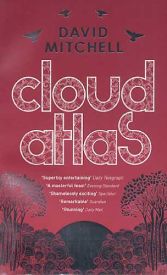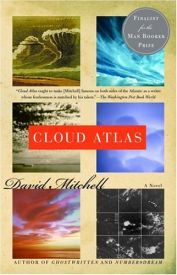David Mitchell – Cloud Atlas


(Sceptre Books, London 2004, ISBN 0340822775, Random House, 0-375-50725-6)
David Mitchell Index — Cloud Atlas Rezension
![]()
LinksTime and Emotion Study — by Hephzibah Anderson, Sunday February 29, 2004, The Observer:"David Mitchell is a master of fragmentary fictions. (…) Cloud Atlas is made up of half–a–dozen disparate but artfully interwoven narratives that propel the reader forwards through time and genre, from the distant nineteenth to the not–so–far–off twenty–second century, from giddy picaresque to cool thriller to chilling sci–fi." Strangers on the same Page: Mitchell’s Novel pulls off a Tricky Narrative Feat — by Tom Barbash, Sunday, October 10, 2004, San Francisco Chronicle: The various strands of the book are held together through a series of interruptions. A story begins, gets cut off, and another starts, until we reach the sixth story, which is told in its entirety. After this, the stories are told in reverse order, along the lines of the musical composition ("The Cloud Atlas'') arranged by one of the protagonists, Robert Frobisher. Silver Daggers and Russian Dolls — David Mitchell, author of Cloud Atlas, in interview, by Shane Barry, March 2005, Three Monkeys Online: "The novel really began with the structure, the Russian Doll structure. The main issue I had to approach was how to make the various novellas fit inside each other and to come up with ways of making the preceding narrative appear as an ‘artefact’ of the succeeding narrative. And the thing was to do that thematically, so the whole thing wasn’t a butcher’s shop exercise with stories meaninglessly presented in a gimmicky way, without adding up to much. I would write the first draft, say, of the Adam Ewing story [the story set on a sailing ship and a Pacific island during the 19th century] in its entirety, think about where I could put a cliff-hanger—which is where the splice was made—think about how it might appear in the next narrative, which in that case was as a torn–in–two book. I did that five times, except of course for the sixth story, the one in the middle, which doesn’t appear anywhere else. Because with the central narrative, as Johnny Rotten famously put it, there’s no future." History Is a Nightmare — by Tom Bissell, Sunday, August 29, 2004, The New York Times: "With the exception of Zachry’s tale, the book’s thematic centerpiece, we visit each of these stories twice, in the following order: 1, 2, 3, 4, 5, 6, 5, 4, 3, 2, 1. Each story is written quite differently — so much so that ''Cloud Atlas'' feels like a doggedly expert gloss on various writers and modes. The archaic Ewing section, rendered in journal form, becomes Defoe, possibly Melville. The epistolary Frobisher story is, perhaps, Isherwood or some other sturdy English master. The Luisa Rey section, written in breathlessly lousy prose, is some species of sub–Grisham. The urban comedy of Tim Cavendish’s antics is well within Martin Amis’s city limits. The plight of Sonmi–451 is Huxley (or ''Blade Runner''). And the daymare of Zachry’s postapocalyptic world is something out of William S. Burroughs in a ''Cities of the Red Night'' mood. Taken as a whole, ''Cloud Atlas'' seeks to give the novel a steely new rigging of the possible. It is an impressive achievement. Unfortunately, impressive is usually all that it is." Overlapping Lives — by AS Byatt. Saturday March 6, 2004, The Guardian: "The first tale is about a 19th–century American lawyer, Adam Ewing, crossing the Pacific in 1850, meeting Maoris and missionaries, a seedy English physician and some nasty sailors. The second is about a young British composer in 1931, who cons a dying genius into taking him on as an amanuensis, and then makes love to his wife and daughter. This narrator, Robert Frobisher, composes the Cloud Atlas Sextet "for overlapping soloists" on piano, clarinet, cello, flute, oboe and violin, "each in its own language of key, scale and colour". Frobisher’s tale is told in a series of letters to his lover, Rufus Sixsmith, who later appears as a nuclear scientist in Reagan’s California in the 1970s. This Californian thriller is the tale of Luisa Rey, a journalist who uncovers a corporate nuclear scandal and is at constant risk of assassination. The fourth voice is Timothy Cavendish, a 1980s London vanity publisher, trapped in an old people's home near Hull. The fifth is the pre–execution testimony of Sonmi–451, a cloned slave in some future state, who has acquired intelligence and vision. The sixth, and central one, is the storytelling voice of Zachry, a tribesman after the fall of the civilised world, who is back in the Pacific islands where the linear narrative began. The novel opens with one ship – the Prophetess – and ends with another ship that contains the survivors of Civ’lise, the Prescients." Apocalypse, Maybe — Interview by Melissa Denes. Saturday February 21, 2004, The Guardian: "His books are dense, noisy with life — a string of multi–layered narratives. (…) His books are dense, noisy with life – a string of multi–layered narratives. All of which makes Mitchell sound an annoyingly tricksy writer, and it’s true that his critics have him down as a bit of a clever clogs, too ambitious for his own good. But what saves his books from being just brilliant formal experiments is the heart with which he writes, the humour, and the absolute conviction with which he draws his characters. He will spend ages writing biographies for all his narrators, working out the speech patterns and the childhood traumas, before he even starts on the ghost of a story. His new book has a brilliant comic creation in the character of Timothy Cavendish, a louche publisher who had a walk–on part in Ghostwritten, and a lot of good jokes — my favourite being a tantric sexual position called the Plumber (you stay in for ages and nobody comes)." Dendroglyph — Chatham Inseln. The Pacific Journal of Adam Ewing — das erste Kapitel des Romans als PDF-Datei. Time Pieces: Cloud Atlas by David Mitchell — Review by W. R. Greer, ReviewsOfBooks.com. "Should you read Cloud Atlas? If you appreciate literary fiction, then this is a novel you should read at least once. Maybe more. It will challenge you, intimidate you, frustrate you, and dare you to think about the important questions it raises. It may not, however, grab you and pull you along with its storylines. That doesn't necessarily detract from its importance or its brilliance. David Mitchell may be more intelligent than the rest of us, and he has some interesting and important ideas he wants to explore with his readers. Read Cloud Atlas." Cloud Atlas — by John Freeman, August 22, 2004, St. Louis Today. "In England, Mitchell is already being called his generation’s Thomas Pynchon, and indeed they do share a penchant for pyrotechnics. His work also shares Pynchon’s often overlooked serious moral core. Watching Mitchell’s characters act, and then seeing how their actions reverberate across time, it’s hard not to agree that causality may be one of the thorniest moral issues in existence. What we do today in our own private lives may have consequences for people in the next millennium." Atlas shrugs: David Mitchell gets off on his Cloud — by Peter Keough, August 27 – September 2, 2004, The Boston Phoenix: The technique sounds as if it might be annoying in a concert hall, but between two covers, it’s a page turner, using the oldest trick in the books, the cliffhanger, or "narratus interruptus," as a way of intensifying suspense and concealing limitations. Moreover, Mitchell masters the "key, scale, and color" of each of his soloists’ language, making them sing with an effortless, Mozartian grace. David Mitchell Radio Interview — by Ramona Koval, Sunday 20.02./2005, ABC Radio National. Ramona Koval: Your MA in comparative literature was on post-modernism, wasn’t it? Or the post–modern novel … Cloud Atlas: An Excerpt and an Interview — at Litblog. "Cloud Atlas" by David Mitchell — by Laura Miller, Sept. 2, 2004, Salon. Meuterei ohne Bounty — Stephen Morris von der Band New Order empfiehlt den Roman. Geschichte Neuseelands — unter besonderer Berücksichtigung der im Roman erwähnten Invasion Rekohus durch die Maori. Auf diesen Seiten findet man auch Bilder von Dendroglyphen und von einem Tui. Cloud Atlas — eine schwedische Rezension auf NOM: Detta är en pusselbok, dock inte på samma sätt som Da Vinci-koden eller någon av de många andra böckerna i samma genre som är så populära just nu. (…) Cloud Atlas är en labyrint av olika stilar och självreferenser, allt författat med en teknisk virtuositet som imponerar. Cloud Atlas by David Mitchell: Islands of the Day Before — by Lawrence Norfolk, 27 February 2004, The Independent. David Mitchell Interview — 10.06.2004, Oxygen. ‘Atlas’ Plots Stellar Trip — By Ashley Simpson Shires, August 20, 2004, Rocky Mountain News. Books on Japan: Cloud Atlas — Joe Sinclair interviews David Mitchell about Japan and his new book, Cloud Atlas, 2004, Japan Visitor. Cloud Atlas by William Skidelsky, New Statesman: Six narratives are grouped chronologically (…) Rather than allowing these narratives to proceed uninterrupted, however, Mitchell breaks off the first five in the middle, resuming them — in reverse order — after the Pacific Islander has completed his yarn. And in each case, the reason for the interruption becomes apparent only later on. All the narratives in Cloud Atlas (except the last) reappear in succeeding tales as physical documents, which the protagonists of those tales start to read, before being interrupted. So Cloud Atlas has an essentially dramatic structure: each narrative is "contained" within the next, making the novel as a whole resemble — as the author himself points out — a set of Russian dolls. From Victorian Travelogue to Airport Thriller — by Theo Tait, The Telegraph: David Mitchell is an alarmingly versatile writer, and his third novel, like its predecessors, contains multitudes. His six main characters are stationed at wildly different points across the globe and human history, but ingeniously accommodated within one elegant, over–arching scheme. This is sketched out in miniature when one of these characters composes a sextet for "overlapping soloists" on six different instruments. "In the first set, each solo is interrupted by its successor: in the second, each interruption is re–continued, in order." David Mitchell: Cloud Atlas — by Margie Thomson, 05.04.2004, New Zealand Herald. "Souls cross ages like clouds cross skies, an’ tho’ a cloud’s shape nor hue nor size don’t stay the same it’s still a cloud an’ so is a soul," muses young Zachry, the narrator of the central segment of this 11-part novel of interruption, backwards referencing and echoes. Cloud Atlas by David Mitchell: Welcome to a World where Fabricants Live on Soap — by Matt Thorne, 29 February 2004, The Independent. ‘Cloud Atlas’ by David Mitchell — by Susan Tranter, April 2005, Encompass Culture. Only Connect . . . and Connect . . . A Journal within a Series of Letters within a Mystery Novel – and that’s just the Beginning — by Jessica Winter, August 17th, 2004, The Village Voice. Q&A: Book World Talks With David Mitchell — Sunday, August 22, 2004, The Washington Post: "Each of the six sections has a model. My character Ewing was (pretty obviously) Melville, but with shorter sentences. Frobisher is Christopher Isherwood, especially in Lions and Shadows. Luisa Rey is any generic airport thriller. Cavendish is Cavendish — he has a short part in the "London" section of my first novel, Ghostwritten. The interview format for "Sonmi" I borrowed from gossip magazines in which a rather gushing hack interviews some celeb bigwig. Zachary owes (of course) a big debt to Riddley Walker, a novel by Russell Hoban, though some reviewers point to "Mad Max 3." (Thanks guys.) I can't claim that Don DeLillo's monumental Underworld is a model for Cloud Atlas, but reading him always encourages me (like drinking) to take literary risks. (Both books, I just noticed, have upbeat endings, against the odds.)" |


